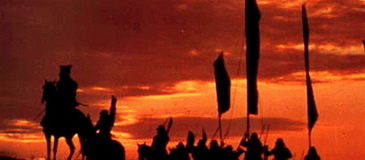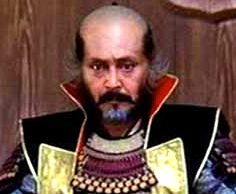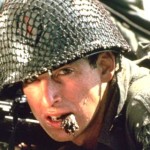 Akira Kurosawa’s suicide attempt was almost a decade behind him. He hadn’t made a film in almost five years, and Japan’s major studios had rejected his latest project, an epic tale of warlords clashing in the 16th century.
Akira Kurosawa’s suicide attempt was almost a decade behind him. He hadn’t made a film in almost five years, and Japan’s major studios had rejected his latest project, an epic tale of warlords clashing in the 16th century.
“I thought another script of mine would vanish into the void,” the aging director recalled years later.
This time, Kurosawa fought his way out of the lower depths, obsessively painting a series of 200 watercolor storyboards for the project to be called “Kagemusha.” A painter of great power in the Japanese tradition, he felt that admirers at least would be left with a glimpse of his brooding yet colorful visions.
The wildly successful American filmmakers George Lucas and Francis Ford Coppola, both students of Kurosawa’s black-and-white classics, eagerly came to the master’s aid, bringing Hollywood clout and money as executive producers.
Lucas, whose “Star Wars” owed much to Kurosawa’s “The Hidden Fortress,” persuaded Fox to pick up international rights, essentially funding production, which began early in 1979. “Nobody bought Japanese films,” Lucas recalls. Fox’s widely admired Alan Ladd Jr. “did it as a favor to me.”
“Kagemusha” went on to win the Palme d’Or at the Cannes Film Festival, dazzling the jury with its scope and visuals. The film ran its full three hours in Japan but was trimmed by 20 minutes for the U.S., where the critical reaction was respectful but muted.
 Kurosawa’s watercolor storyboards and sketches, meanwhile, found new life in a side project created by one of the “Kagemusha” actors. Audio snippets from the film accompanied a chronological slide show of the paintings, running a brisk 43 minutes. Kurosawa gave his blessing to the shadow film, called “Image: Kurosawa’s Continuity.”
Kurosawa’s watercolor storyboards and sketches, meanwhile, found new life in a side project created by one of the “Kagemusha” actors. Audio snippets from the film accompanied a chronological slide show of the paintings, running a brisk 43 minutes. Kurosawa gave his blessing to the shadow film, called “Image: Kurosawa’s Continuity.”
Both the full-length film (180 minutes) and the storyboard film made their U.S. debuts in Criterion’s double-DVD edition of “Kagemusha.” (The running time was wrong on some packaging and on Amazon.) The title was released in March 2005 and then upgraded to Blu-ray in August 2009.
They’re both terrific home videos editions that remain required viewing for Kurosawa’s faithful. Owners of the DVD may want to sit tight, as the high-definition upgrades, good as they are, don’t present a compelling reason for casual fans to upgrade. The extras are identical. Both editions serve as a potent response to critics who maintain that the director’s powers faded after the late ’60s.
On the “Kagemusha” Blu-ray, colors re-emerge bold and saturated, with images bordering on hyper-realistic. The 1970s film stock retained a fair amount of grain, but it’s rendered harmless by the raging colors. Wear is at a minimum, limited to some speckling and spotting. The film unspools letterboxed at an aspect ratio of 1.85:1 (on both Blu-ray and DVD).
The DTS-HD Master Audio 4.0 soundtrack is as good as it gets with a foreign film of this age. The taiko drums roll out just like thunder on the lossless track while the rush of hooves fills the listener’s room. Dialog is crisp and clear, so all those warlord tirades retain their power.
Stephen Prince, commentator on the Criterion DVD of “Ran,” the director’s other color epic, gets the nod again on “Kagemusha.” The author of the Kurosawa book “The Warrior’s Camera” repeats the feat of lecturing with both authority and verve throughout the lengthy feature.
Prince points out where most of the cuts were made for the Americans, accurately calling the complete film found on the Blu-ray “a richer and more organic presentation.”
The extras lead off with Lucas and Coppola looking back on Kurosawa and “Kagemusha” in 19 minutes of interviews filmed in 2004.
Kurosawa captured violence in a “poetic, surprising way” that schooled the young American directors of the 1970s, Coppola says. “You could trace a line backwards from ‘The Godfather’ to ‘Bonnie and Clyde’ to Kurosawa,” he says.
 The Japanese director “always had a great story to tell,” Lucas adds. At the same time, his images “sear themselves into your mind.”
The Japanese director “always had a great story to tell,” Lucas adds. At the same time, his images “sear themselves into your mind.”
Some of the more dramatic storyboards reappear on the Blu-ray in a split-screen comparison with finished scenes. In a fun extra, Coppola clinks glasses with Kurosawa in an odd TV ad for Suntory whiskey, a pitch clearly lost in translation.
A 40-minute episode of the (highly recommended) Kurosawa documentary series “It’s Wonderful to Create” runs down the story of the production, in which the director stunned Japanese film fans by firing his popular star, Shintaro Katsu of “Zatoichi” fame. (The martial arts star dared to bring his own film crew on Day 1 of production.)
Prince explains some of the tepid reaction to the film by noting that the dual lead roles — of a mortally wounded warlord and his reluctant peasant double — were designed and written for Katsu, who was gifted in both drama and comedy. Instead, Kurosawa made do with the classically trained Tatsuya Nakadai (“Yojimbo”), giving the proceedings a sterner tone than intended.
“Kagemusha” also put off devotees of Kurosawa’s earlier heroic and humanistic works because the aging director kept his warlords and their advisers at a distance, Prince says. The result is “a certain coldness.”
Yet, the biographer insists, there exists an undeniable “deep emotion” throughout the Kurosawa work.
“Kagemusha,” which translates as “Shadow Warrior,” works on a surface level as a take on illusion and reality, but those wise enough to dig deeper will need Prince’s help. The commentator provides the historical orientation that Kurosawa rushed past, resulting in baffled foreign audiences.
The film covers the chaotic years of 1573-75, in which clans battled for control of Japan. The samurai who once fought with swords picked up rifles, a sudden advance in the art of war that led to the infamous slaughter at Nagashima and eventually to the unification of Japan.
In the fields of Nagashima, Kurosawa tracks his “beloved samurai era to the point of extinction,” Prince notes. The director looked back with scant nostalgia and ahead to the horrific, apocalyptic events of the 20th century that he knew all too well.
* * *
As for “Ran,” Criterion lost the (StudioCanal) rights to Lions Gate, which issued a Blu-ray version in early 2010. Criterion’s “Ran” DVD came out in 2005. Subtitles and extras are different. Either will do, but stay away from the “Masterworks Edition” of 2003.
Check out Glenn Abel on Google+



Leave a Reply